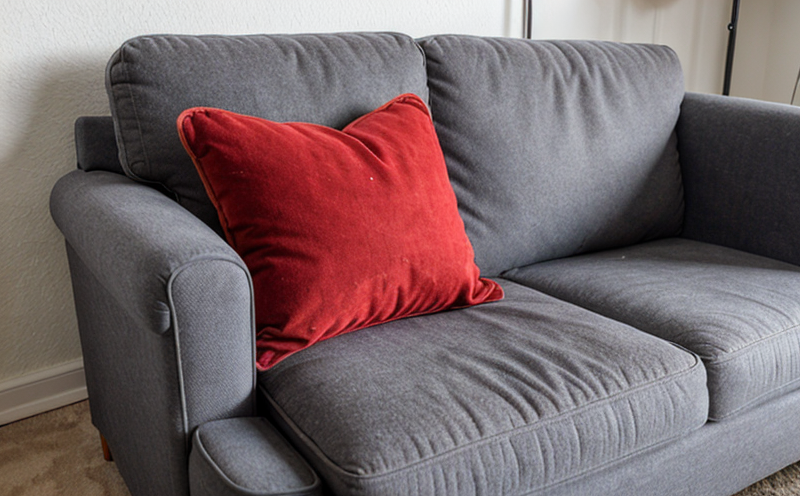ASTM D5034 Breaking Strength Testing of Upholstery Fabrics
The ASTM D5034 standard is a critical tool in the quality control and development process for upholstery fabrics. This test measures the breaking strength of fabric used in furniture, ensuring that the materials can withstand the stresses and strains encountered during use.
ASTM D5034 applies to woven or nonwoven fabrics intended for upholstery applications such as sofas, chairs, and other seating furnishings. The standard is particularly relevant when selecting fabrics that will be subjected to significant stress over extended periods. Testing according to ASTM D5034 helps manufacturers identify materials with adequate durability, preventing potential failures in the field.
The test involves stretching a specimen of fabric until it breaks, recording the force at which this occurs. The breaking strength is reported as the tensile strength of the fabric. This value is crucial for ensuring that upholstery fabrics meet design specifications and are suitable for their intended use.
For accurate testing, specimens must be prepared according to ASTM D5034 guidelines. This includes selecting a representative sample size, cutting the fabric into standard test pieces, and conditioning the samples to ensure they reflect real-world conditions.
| Step | Description |
|---|---|
| Determine Sample Size | Select a sample size based on ASTM D5034 specifications. |
| Condition Samples | Maintain samples at specified temperature and humidity levels for 24 hours. |
| Cut Specimens | Cut fabric into the required dimensions using a precision cutter. |
The test apparatus used in ASTM D5034 breaking strength testing includes an Instron tensile tester or similar device. This machine applies controlled force to the specimen, measuring how much force is required before the fabric breaks. The machine must be calibrated regularly and operated by trained personnel.
| Instrument | Description |
|---|---|
| Instron Tensile Tester | A calibrated machine that applies controlled force to the specimen. |
| Suitable Grips | Clamps or grips that securely hold the fabric during testing without causing additional stress. |
The breaking strength of upholstery fabrics is a critical factor in determining their suitability for furniture. Higher tensile strengths indicate greater durability and resistance to wear, which is essential for maintaining the integrity of seating over time. This test also helps manufacturers compare different fabric options to find those that best meet quality standards.
ASTM D5034 testing ensures consistent quality across production batches, providing a benchmark against which other tests can be compared. By adhering to this standard, manufacturers can ensure their products are safe and reliable for consumers.
In summary, ASTM D5034 breaking strength testing is essential for verifying the durability of fabrics used in upholstery furniture. It provides critical data that supports product development, quality assurance, and compliance with industry standards.
Customer Impact and Satisfaction
Implementing ASTM D5034 breaking strength testing ensures customer satisfaction by delivering high-quality, durable products. Furniture manufacturers who use this test can provide customers with confidence that their seating will withstand the rigors of daily use without compromising on style or comfort.
By ensuring that upholstery fabrics meet strict tensile strength criteria, companies demonstrate a commitment to quality and reliability. This not only enhances brand reputation but also reduces warranty claims and returns due to premature failure.
Customer satisfaction is further improved when manufacturers can provide detailed test results from ASTM D5034 testing. Transparency regarding the durability of fabrics used in products encourages trust between manufacturer and customer, fostering long-term loyalty.
Moreover, compliance with international standards like ASTM D5034 reflects a commitment to excellence that resonates positively among environmentally conscious consumers who value sustainable practices. This aligns well with broader trends towards eco-friendly consumer goods.
Environmental and Sustainability Contributions
ASTM D5034 breaking strength testing plays a role in promoting sustainability by ensuring that upholstery fabrics are selected based on their durability, which reduces waste associated with frequent replacements. Longer-lasting furniture contributes to reduced resource consumption and landfill contributions.
Durable materials also contribute positively to the circular economy model by extending product life cycles, encouraging reuse and recycling rather than disposal after minimal use. This aligns with broader sustainability goals within various sectors including manufacturing and retail.
Additionally, manufacturers who prioritize ASTM D5034 compliance demonstrate a responsible approach towards resource management. By selecting fabrics that meet the specified breaking strength criteria, companies contribute to minimizing environmental impact through efficient material utilization.
Use Cases and Application Examples
- Home Furniture Manufacturers: Ensure that upholstery fabrics used in sofas, chairs, and armchairs meet durability requirements as specified by ASTM D5034.
- Commercial Facility Owners: Verify that seating provided for offices or public spaces is capable of withstanding regular use without compromising on aesthetics.
- Contract Furniture Suppliers: Guarantee the longevity and reliability of fabrics used in contract furniture, especially for high-traffic areas like airports and hotels.
The following table highlights specific scenarios where ASTM D5034 testing is particularly beneficial:
| Scenario | Description |
|---|---|
| New Product Development | Determine the optimal fabric for a new line of furniture. |
| Supplier Evaluation | Select reliable suppliers based on their product performance. |
| Quality Assurance | Monitor ongoing production to ensure consistent quality. |





